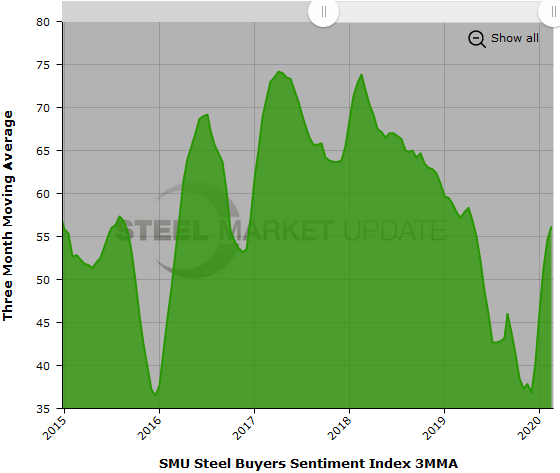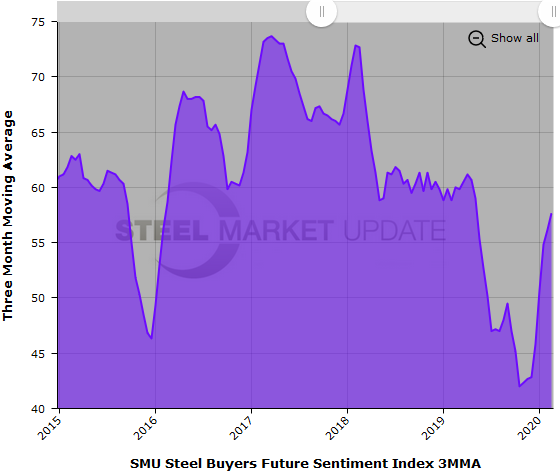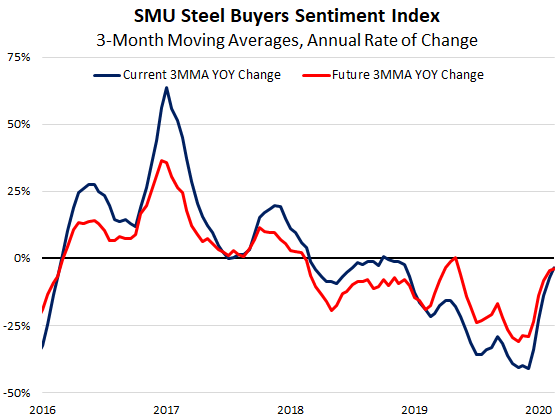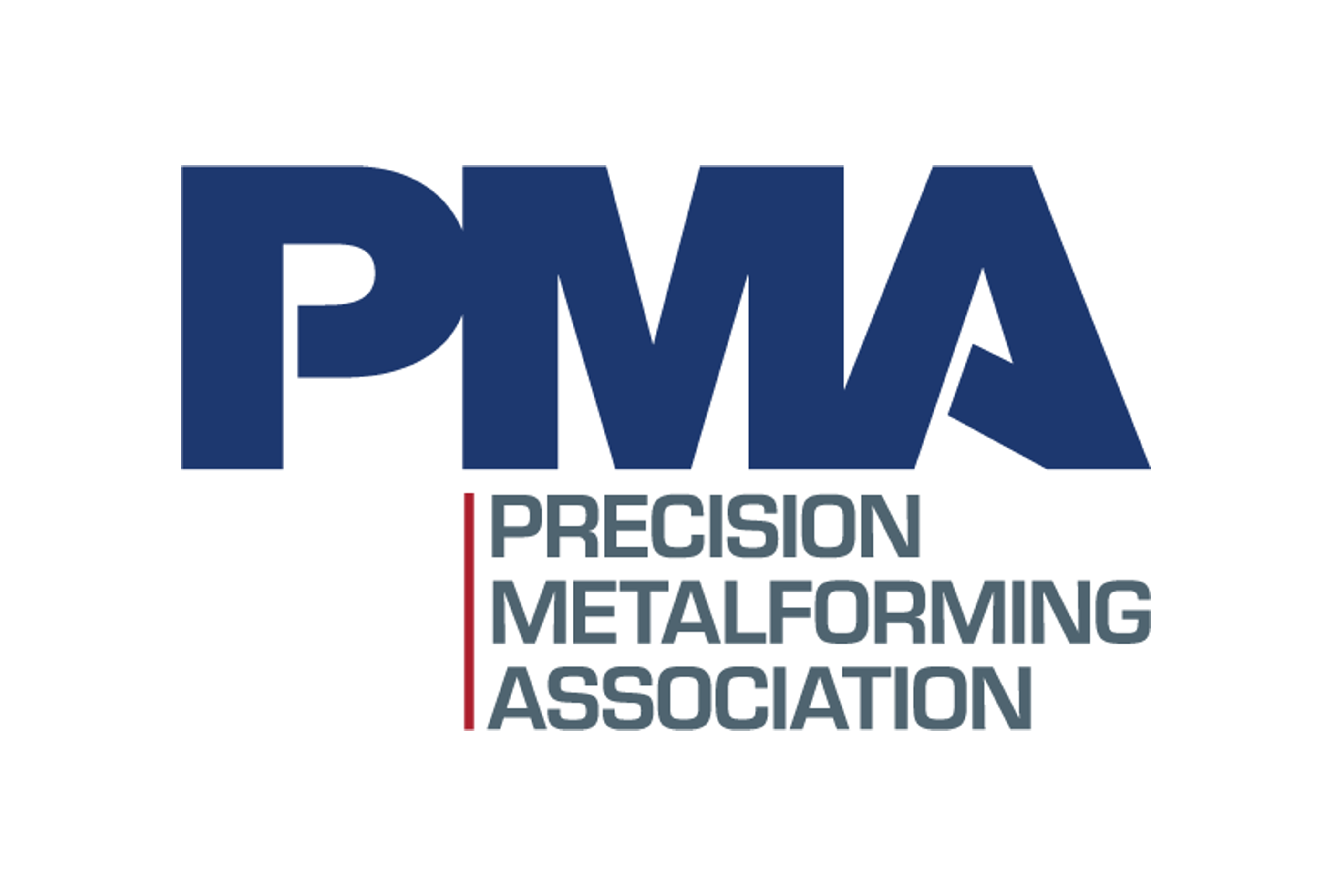Market Data

February 23, 2020
SMU Steel Buyers Sentiment Index: Relatively Steady
Written by Tim Triplett
Steel buyers sentiment, as measured by Steel Market Update, has remained relatively steady at a fairly optimistic level since the beginning of the year. But both Current and Future Sentiment have registered a very slight decline in the past few weeks.
SMU’s Current Sentiment Index registered +56 this week, down from +63 at this time last month. The Future Sentiment Index has dipped to +60 from +63 four weeks ago. Neither change is very significant and leave sentiment at strong levels well above the six-year lows in the 20s and 30s registered in September and October 2019.
The goal of SMU’s index is to measure how buyers and sellers of steel feel about their company’s ability to be successful today (Current Sentiment Index), as well as three to six months into the future (Future Sentiment Index). Results from SMU’s market trends questionnaire this week are posted as both single data points and as three-month moving averages (3MMAs) to smooth out the trend.
As a single data point, the Current Sentiment reading of +56 is three points lower than at this time last year. Measured as a 3MMA, Current Sentiment is at +56.17, up from +54.67 in early February. At this time last year, the Current 3MMA was slightly higher at +57.83.

Future Sentiment
Future Sentiment as a single data point at +60 is five points below this time last year. The Future Sentiment 3MMA is +57.67, up from +56.17 a couple weeks ago, but below the +60.00 reading in February 2019. Two months into 2019, a year that turned out to be challenging for the steel industry, buyers were slightly more bullish on their future prospects than they are now looking forward into 2020.
All the current readings are above zero and on the optimistic half of SMU’s scale, therefore generally positive.

The upturn in sentiment since fourth-quarter 2019 can be seen on the right in the chart below, which tracks the annual rate of change in the three-month moving averages, but the trend has begun to flatten this year.

What Respondents Had to Say
“As an importer, Section 232 has significantly affected our supply base.” Trading Company
“We purchased six months of steel at the bottom.” Manufacturer/OEM
“We are seeing strong open orders from our dealers.” Manufacturer/OEM
“Plate demand needs to increase.” Service Center
“Construction activity was very consistent through the winter and I think we are poised for a strong spring.” Manufacturer/OEM
“Demand is starting to wane again. It’s somewhat concerning. We’ve been fairly optimistic the past few weeks, but now the tide is turning.” Manufacturer/OEM
“Demand seems softer than is typical for this time of year, plus there appears to be no set direction for pricing! Plenty of supply available!” Service Center
“We’re positive, as long as the weather holds out and nothing crazy happens regarding the election.” Manufacturer/OEM
“Plate demand should increase in the spring.” Service Center
“Business is still very good.” Service Center
“Being an election year, there is always some skepticism about business activity waning.” Manufacturer/OEM
“Nothing has positively changed to help our business going forward.” Trading Company
“Fair and free trade continues to be attacked. The WTO issue is a sad state and the future of this mechanism to regulate world trade is questionable. Walls, figuratively and literally, are being built in a more dangerous and more fragile world.” Trading Company
About the SMU Steel Buyers Sentiment Index
SMU Steel Buyers Sentiment Index is a measurement of the current attitude of buyers and sellers of flat rolled steel products in North America regarding how they feel about their company’s opportunity for success in today’s market. It is a proprietary product developed by Steel Market Update for the North American steel industry.
Positive readings will run from +10 to +100 and the arrow will point to the righthand side of the meter located on the Home Page of our website indicating a positive or optimistic sentiment. Negative readings will run from -10 to -100 and the arrow will point to the lefthand side of the meter on our website indicating negative or pessimistic sentiment. A reading of “0” (+/- 10) indicates a neutral sentiment (or slightly optimistic or pessimistic), which is most likely an indicator of a shift occurring in the marketplace.
Readings are developed through Steel Market Update market surveys that are conducted twice per month. We display the index reading on a meter on the Home Page of our website for all to see. Currently, we send invitations to participate in our survey to more than 600 North American companies. Our normal response rate is 100-150 companies; approximately 40 percent are manufacturers, 45 percent are service centers/distributors, and 15 percent are steel mills, trading companies or toll processors involved in the steel business. Click here to view an interactive graphic of the SMU Steel Buyers Sentiment Index or the SMU Future Steel Buyers Sentiment Index.







